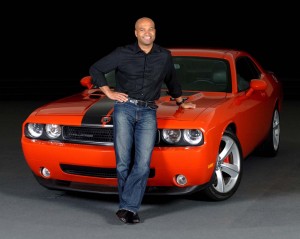Fiat Chrysler boss Sergio Marchionne has always said he wants to remake the Italian-American amalgamation into one company and so far there has been minimal resistance to his vision. But now Marchionne is moving to put his vision into practice and treading on the sacred turf of Italian design to do it.
Italian design is world-renowned in everything from fashion to footwear to architecture and, of course, automotive design. But Marchionne has elected to put an American in charge of the merged companies design studios worldwide.
Fiat Chrysler Automobiles N.V. has named Ralph Gilles, a key member of Chrysler’s design staff for two decades, as Head of Design for the entire company and member of the FCA Group Executive Council (GEC). The GEC is the highest management-level decision making body within the FCA organization and is led by the FCA Chief Executive Officer.
Gilles currently leads the FCA North American Design Office as Senior Vice President, a position he was named to in June 2009. FCA US hasn’t named a replacement for Gilles.
Gilles succeeds Lorenzo Ramaciotti, who is retiring after several years of dedicated service with the company. Ramaciotti will continue to lend his expertise to the group serving as a Special Advisor to the CEO, which means he’ll be available to help dry the tears of the frustrated Italians who didn’t get the job.
“We extend our sincere appreciation to Lorenzo for his unwavering dedication, service, leadership and many contributions to the organization,” Marchionne said in a statement issued with the announcement of Gilles promotion.
On one level, Gilles’ promotion makes a great deal of sense. He is, after all, one of the few Chrysler executives to whom Marchionne turned when he was still considering buying Chrysler even prior to the company’s bailout by the federal government. Gilles recounts by Christmas, 2008 he was seriously worried that Chrysler might not survive the winter but Marchionne held out hope for him and for a small cadre of Chrysler executives.
Since then Gilles has been on of Marchionne’s top lieutenants.
Marchionne also has made sure Gilles has gotten additional experience beyond the design dome in Auburn Hills, Michigan, making him CEO – Motorsports; President and CEO – SRT Brand and CEO – Dodge Brand for FCA US in addition to his leadership role in Design.
Now Gilles is being given a chance to bring an American perspective to Italian studios with a long history and a strong tradition of producing terrific designs for the Fiat, Alfa-Romeo, Maserati and even Ferrari, which is now being separated from Fiat Chrysler through a spinoff.
(Pickup, plug-in hybrid appear on Jeep’s horizons. For more, Click Here.)
Gilles originally joined the Chrysler in 1992 after graduating from College of Creative Studies in Detroit. He also holds a Master of Business Administration from Michigan State University
After joining Chrysler, Gilles quickly made his mark as a brash, young designer. Well before the Germans decided to dump Chrysler, Dieter Zetsche, then the head of the Chrysler Group, selected Gilles to help translate the preliminary sketches of what was known as a “tall sedan” by Freeman Thomas, who then headed Chrysler’s advance design studio, into a working model. The Chrysler 300 debuted in the Spring of 2004 and was a great success and made Gilles into a rising star.
(Click Here details about Chrysler leaving the UK.)
Born in New York City into a Haitian immigrant family and raised in Montreal, Gilles was drawing cars at age 8. In the early 1980s, his sketches caught the attention of an aunt, who wrote to then-Chrysler Chairman Lee Iacocca for advice. A few weeks later, a letter urging Gilles to attend design school arrived from K. Neil Walling, then Chrysler’s design chief.
“I’ve been pretty outspoken from Day One,” Gilles recalled in one interview.
(To see what new alliances FCA could seek in the future, Click Here.)
While designing the interior of the Jeep Liberty, his first production vehicle, he got in a fight over chrome ornamentation, which other executives were convinced was too pricey. He recalls a meeting that wasn’t going his way. “I got really emotional,” he says. “For the first time in my life I made an impassioned plea to the marketing guys that this is something you have to pay for. If you don’t, you’re really screwing up the car,” noted Gilles, who also loves racing and says he likes nothing better than a weekend at the track.
Chrome was a design element in several Chrysler models, notably the 300, one of the most successful full-size cars built by Chrysler. To this day, the 300 is noted for the subtle kind of “Motor City Bling,” that has been part of Gilles design language.


I’m sure Gilles has no intention of screwing up excellent Italian design. More than likely he will find ways to infuse the Italian design into Chrysler products to raise their public perception via some Italian styling cues. If there is anything Chrysler design has of value that can be applied to Fiat, then Gilles can apply it. And if the whole deal goes South in a few years as expected, everyone will be shuffled around to some new company or position.